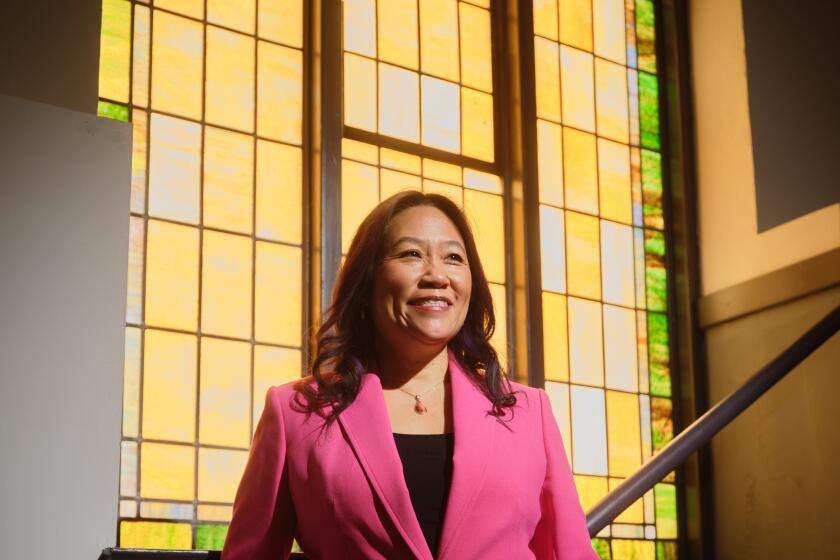DANCE REVIEW : Misha’s Tharper Image : The New Twyla Show Offers More Glamour Than Art
So, you want to know, how was the big Twyla and Misha Show Wednesday night at the new Cerritos Center for the Performing Arts?
Compared to what?
Compared to a visit to the dentist for root-canal work it was bliss. Compared to the usual, and not totally unrelated, hippety-hop extravaganzas in Vegas, it was pretty good. Compared to “Dirty Dancing” it was clean. Compared to MTV it was moderately snazzy. Compared to the presidential inauguration it was taut. Compared to “The Rite of Spring” it was loose. Compared to “Body of Evidence” it was sublime.
I can just see the ads now. “ ‘Bliss . . . Pretty . . . Good . . . Clean . . . Snazzy . . . Taut . . . Loose . . . Sublime.’-- L.A. Times .”
Wow.
But forget the diversionary tactics. How was “Cutting Up”--that’s the official title of the revue--compared to “Deuce Coupe,” to “Push Comes to Shove,” to “Sinatra Songs” and to “In the Upper Room”?
Well . . .
There were pleasant moments, and most of them looked deucedly familiar. In this context, deja vu isn’t quite what it used to be.
Don’t get me wrong. Any performance that showcases the quirky, slick, classically oriented bravura of Mikhail Baryshnikov, even at a slightly diminished 45, can’t be bad. Any production that is put together by Twyla Tharp, still a deliriously perky, irresistibly appealing yet chronically nonchalant rag-doll at 51, can’t be dull.
Any package that contains such deliciously diverse, potentially comic talents as the towering Aaron Cash and the brash Art Palmer in the excellent nine-body supporting cast, plus the suavely bounding Jamie Bishton, can’t be totally lacking in compulsion.
Still, with such ingredients, the result should have been a wondrous, unconventional buffet. Twyla and Misha, alas, seem more interested here in microwaving some lite fast-food. They serve it, moreover, with plastic utensils instead of fine silver.
It is always interesting, of course, to see Baryshnikov, the charismatic high-speed classical paragon, allowing himself to be recast in the Tharper image. It is fascinating to watch him stretch in order to slouch. It is fun, again, to observe his innate elegance filtered through street funk.
And now that the cruelties of time--not to mention the exigencies of fragile knees--have diminished the prince’s leap and deprived him of his lift, it is reassuring to be reminded that style and charm can still work some compensatory magic.
Baryshnikov may not muster much of a Nijinsky imitation anymore--though he certainly exults in a few satirical jabs in the direction of invisible swans and Wilis. Still, his Jimmy Cagney imitation remains inimitable.
Tharp runs her seemingly combative disciple through some picturesque old-soft-shoe routines. She engages her cool and distant partner--I don’t think they ever even touch--in some pointed anything-you-can-do-I-can-do-different routines. She devises fancy and sometimes frantic solos--for him and for her--that play divertingly with pop sensibilities.
She conjures still-useful images of a cheeky and oddly vulnerable, perpetually shrugging imp. As such, she is the unifying force in an interrelated survey of art dance as it relates to show-biz dance as it evolves into social dance.
Tharp and her apparently eager followers spend the evening dabbling, knowingly, in distorted nostalgia. They savor cheap perfume and second-hand whimsy. They respond appreciatively to a soundtrack that spans the tinniest pan-alley tunes and the most precious Pergolesi sinfonias, and they make telling use of one very busy live musician: the pianist Sterling Smith.
The result is an amusing, undeniably stellar camping trip for the uninitiated. Much of the capacity crowd in Cerritos, Ca. 1,450, obviously had a good time. Those who know and love the best of Tharp, however, not to mention those who recall the best of Baryshnikov, felt a bit deprived.
The three-part extravaganza offered little that was new, either in idea or in content. Essentially, the stuff that had been done before had been done better. The jokes looked a bit stale.
The resident geniuses seemed to be flying here on automatic pilot, and not flying very high. Sometimes the line between homage and parody became fuzzy.
The program is neatly divided in three half-hour parts separated by (unannounced) 15-minute intermissions. The first, and weakest, section is labeled “Schtick.” This is a baby Broadway bonanza in which the stars roam the boards clutching bottles of drinking water when they aren’t zipping into tired jazzy routines. Here and there, some mini-ballerinas in black tutus provide incongruous punctuation.
The middle, and best, section finds Tharp and Baryshnikov alone, decked out in matching T-shirts and baggy white pants (Isaac Mizrahi is the versatile designer) and exploring the Baroque implications of an eight-part Pergolesi suite. She mocks the courtly rituals with drooping Pitiful-Pearl accents, yet darts in and out of focus with cheeky elan. He sheepishly mocks his own classical inclinations with nobility that cannot be squelched, much less denied.
The final section flirts with trendy jumping, jiving and jitterbugging. Things like that. The pretended locales support historic resonances: the Palm Court, the Cocoanut Grove, the Rainbow Room (where Baryshnikov gets to do his still thrilling Sinatra number, “One for My Baby”), and, for the predictably feverish finale, Morton’s LA.
Incidental intelligence regarding Cerritos’ new hall:
From the seat provided by the management--at the extreme rear of the orchestra level--the overview was fine. But, if the dancers ever flexed any facial muscles, that expressive act remained a mystery to at least one viewer.
A visit to the upper reaches revealed the top balcony to be something dangerously akin to nosebleed heaven. The side boxes seemed to assure a pain in the neck for any foolish occupant who wanted to watch the action on the stage, as opposed to the action in the audience.
The overamplification system created the same low-fidelity problems with the old recordings and the live piano playing. When it comes to sonic distortion, the Cerritos Center must be an equal-opportunity employer.
More to Read
The biggest entertainment stories
Get our big stories about Hollywood, film, television, music, arts, culture and more right in your inbox as soon as they publish.
You may occasionally receive promotional content from the Los Angeles Times.






